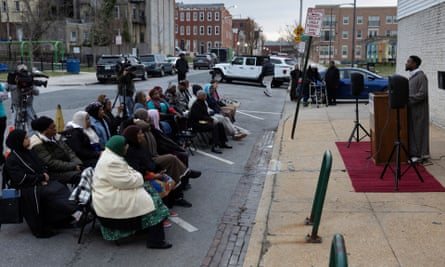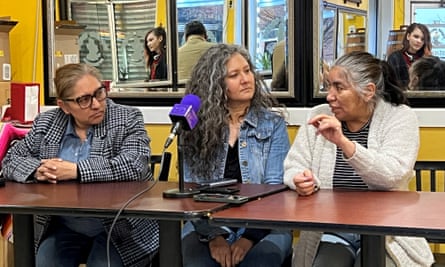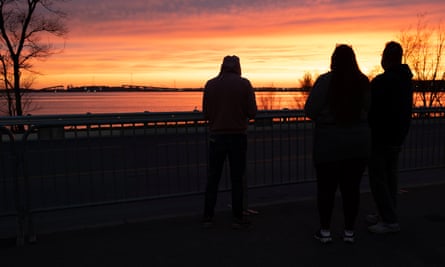‘We’re tough’: Baltimore pulls together after bridge collapse
Baltimore’s Francis Scott Key Bridge took five years to build and then became an artery on which the blue-collar American city relied for nearly 50 years.
But it was gone within a few seconds when a huge cargo ship exiting the city’s port struck it on Tuesday, toppling the landmark and sending at least eight workers plummeting into the frigid waters below. Across Baltimore, as well as the US and the rest of the world, people reacted with shock and horror to videos of the gigantic structure crumpling into the river.
The Key Bridge had become an emblem of Baltimore’s staunch working-class history, providing a route to jobs at plants and warehouses on the city’s harbor. It overlooked the city’s port, which handled 50m tons of cargo last year and directly supports 15,000 jobs.
Fans of the HBO crime drama The Wire were quick on social media this week to recall the bridge featuring prominently in 2003’s season two storylines about the city’s dockworkers: “It’s fucking picturesque,” one character says of the span.
The collision, which the Baltimore mayor, Brandon Scott, said was an “unthinkable tragedy” that “looked like something out of an action movie”, has sent locals into a tailspin. Rebuilding the 1.6-mile-long structure will take years, and for victims’ families, recovery will be ongoing. But locals are confident in their plucky city’s ability to recuperate.
“We’re tough,” said Susana Barrios, vice-president of the grassroots immigrants’ rights group Latino Racial Justice Circle. “We’ve had to be.”
Still, authorities say the port will be closed to traffic “until further notice”. Dockworkers and other laborers are bracing for a difficult fallout.

“A lot of people could be out of work,” said Bill Barry, a former union organizer and labor historian in Baltimore. “Workers in the port and also at the restaurants, equipment providers, subcontractors who provide equipment … all around it.”
All kinds of people have long relied on the port for employment. In the early 1800s, it was a place that Black workers – both free and enslaved – could regularly find work. The abolitionist and orator Frederick Douglass, who was born into slavery, worked as a ship’s caulker in a Baltimore shipyard in the 1830s.
“There’s a lot of history in those jobs,” said Barry.
Jobs in and around the port are often treacherous, and some workers face especially difficult conditions. When the structure collapsed into the Patapsco River at 1.30am on Tuesday, an overnight crew with the company Brawner Builders was atop it repairing potholes. After the crash, two people were rescued from the river.
One of them declined medical attention. Mark Parker, a pastor at Breath of God Lutheran Church in the city’s largely immigrant neighborhood of Highlandtown, said that might have been because they “felt fine, and if so, great”. But many contractors in Baltimore lack health insurance, and some also lack immigration status, he said.
“So they are less likely to seek care and much more likely to turn down care when it is offered, even after falling off a frickin’ bridge into a river,” he said.

Some 35 hours after the disaster, divers recovered two workers’ bodies from a submerged red pickup truck. The victims, and four more people who are presumed dead, have been identified as immigrants originally hailing from Mexico and Central America.
“They were working to support their families,” Jesús Campos, a colleague and friend of the victims, said via a translator on Tuesday at a convenience store parking lot near the bridge entrance.
From the brightly lit Taquería Vargas restaurant on Wednesday night, immigrants’ rights advocates announced they had raised $97,000 in six hours for the victims’ families via GoFundMe.
“This is unfortunately not our first time dealing with disaster here,” said Barrios of Latino Racial Justice Circle, which spearheaded the efforts. They will now hand efforts over to the mayor’s office of immigrant affairs, she said, as it is better suited to handling the funds.
Many other people have sprung into action to support those affected by the disaster. Amanda Mack, chef and owner at the bakery Crust by Mack, has spent the days since distributing comforting food to first responders.
For her, the Key Bridge was something of a legend. Her grandfather would often remind her that his father had worked to construct the landmark in the 1970s.
“He’d point to the bridge and say his father was such a hard worker, and that that showed you had to be something in life, you had to work hard, you had to contribute something to society,” said Mack. It’s a lesson she’d remember every time she crossed the bridge, and one that inspired her to take action after Tuesday’s tragedy.
John Minadakis, president of Jimmy’s Famous Seafood, a 50-year-old restaurant located five minutes from the bridge, said his team was sending meals to the victims’ families. He described Baltimore as “the blue-collar melting pot of America”.
City councilmember Zeke Cohen has been distributing food with the beloved Asian-fusion eatery Ekiben to divers trying to recover victims’ remains. He said hundreds of people have asked him how to help.
“The thing that people who live outside our city do not understand,” he said, “is that when Baltimore gets knocked down, we pull each other back up.”
But actually rebuilding the bridge – the third-longest continuous truss bridge span in the world, according to the American Society of Civil Engineers – will be a long process. Ben Schafer, professor of civil engineering at Baltimore’s Johns Hopkins University, guessed it could be seven to 10 years before a new structure is open to traffic.
“There will have to be a significant amount of study and work,” he said. “It’s a multiyear process to do the design and then fabricate and construct.”

Gabriel Seibel, a 29-year-old diver and union member in Baltimore, said removing debris from the water could take a year or two. He said the main shipping channel could be reopened within a matter of weeks if officials authorized round-the-clock working and there are no major complications, but said the work would be challenging.
“In Baltimore harbor, once you are about 10ft down, it doesn’t matter if it’s day or night, you are feeling with your hands,” he said, adding that visibility will be even more limited than usual because of the huge underwater cloud the bridge collapse has stirred up. “This is going to be a ‘Hail Mary’ call for a little while. No one knows exactly how the steel has twisted and torqued and how it fell.”
William C Sproule, executive secretary treasurer of the Eastern Atlantic States Regional Council of Carpenters, said his workers “stand ready” to help “safely restore the area and the regional economy”.
The Biden administration has said the US federal government will pay the full cost of rebuilding the bridge and help support the port’s reopening.
“You’re Baltimore strong,” Biden said on Tuesday.
In the meantime, some residents are concerned about cascading effects of the port’s closure. In Curtis Bay, a neighborhood just west of the bridge made up predominantly of people of color, for instance, advocates worry that without port shipping lanes, more diesel trucks could speed down their already heavily polluted streets.
The South Baltimore Community Land Trust, a Curtis Bay environmental justice group, is asking state officials to “ensure that the response to this tragedy does not worsen existing health and environmental injustices”, said Greg Sawtell, a director at the organization.
“Strength and resilience in the wake of a disaster,” he said, “will come if and only if power, information and decision-making are shared with workers and communities on the frontlines.”
Additional reporting by Joanna Walters